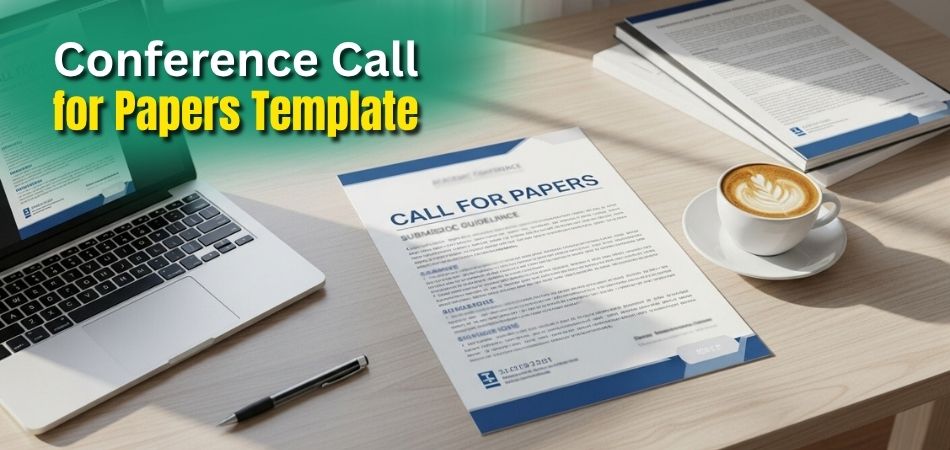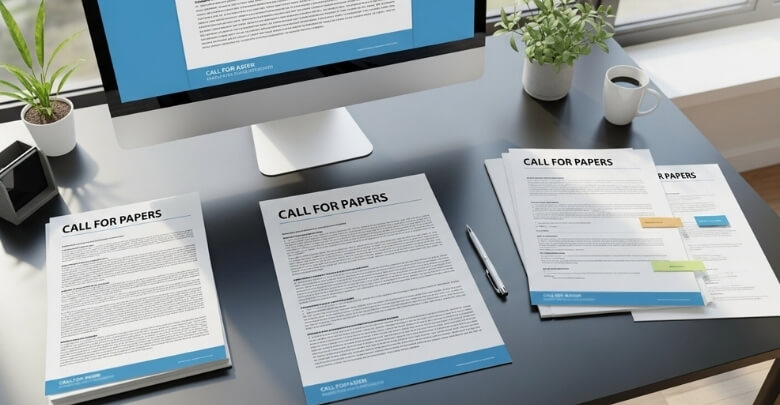Every successful conference begins long before the event day, it starts with the right invitation to share knowledge. A conference call for papers template helps organizers reach researchers, experts, and professionals who can contribute valuable insights and discoveries to the event’s theme. It sets the stage for collaboration and innovation.
In simple terms, a conference call for papers template is a structured guide that explains what topics are accepted, how to submit, and when. It ensures clarity for contributors while maintaining organization and fairness for reviewers. A well-written CFP acts as the bridge between great research and great conferences.
Whether you’re planning your first academic event or managing a large-scale international forum, knowing how to create an effective CFP can make all the difference. Keep reading to learn how to design one that attracts quality submissions and builds conference credibility.
Conference Call for Papers Template
A Call for Papers (CFP) is an official announcement issued by conference organizers inviting scholars, researchers, and professionals to submit their original work for presentation. It outlines the conference theme, submission requirements, and evaluation process, helping participants understand how to contribute their research effectively to the event.

In a broader sense, a CFP acts as the foundation of a conference’s academic or professional framework. It determines the direction of discussions, ensures thematic consistency, and brings together participants with shared interests. A well-prepared CFP establishes credibility and creates a transparent environment where contributors feel confident in submitting their work.
Creating a structured CFP template helps organizers communicate requirements effectively while maintaining consistency and fairness. Let’s explore the key steps to prepare oneself successfully for any professional or academic conference in Canada, the USA, or beyond.
Define the Objective and Audience
Begin by establishing the central goal of your conference and identifying your target audience. Determine whether it focuses on academics, industry experts, or practitioners. This understanding ensures that your CFP calls for papers relevant to your theme, attracts the right participants, and maintains coherence throughout all submitted works and sessions.
Outline Submission Requirements
Specify the submission types you expect, such as abstracts, full research papers, or short reports. Include word limits, citation style, and file format to avoid confusion. When contributors know exactly what’s required, they can submit complete and properly formatted materials that align with your expectations and help streamline the review process effectively.
Set Clear Deadlines and Review Process
Establish clear timelines for submission, review, and notification. Mention if the process involves a peer review, committee evaluation, or external referees. Transparency in this stage builds trust among contributors, helping them prepare their submissions responsibly while ensuring reviewers have sufficient time for evaluation before final acceptance decisions.
Provide Contact and Submission Details
Offer precise contact information and submission channels, such as an email address, online form, or conference portal. Make sure participants can easily reach out with inquiries or technical issues. Providing accessible communication points reduces confusion, encourages participation, and reflects the professionalism of the organizing committee throughout the submission process.
Sample CFP Template (Short Version):
- Conference Title and Theme
- Submission Types (Abstracts, Papers, Case Studies)
- Word Limit and Format
- Submission Deadline
- Review and Notification Dates
- Contact Email or Submission Portal
A well-prepared CFP encourages thoughtful contributions and promotes collaboration. By focusing on clarity, structure, and fairness, organizers can attract meaningful participation and set the stage for a successful and impactful event.
Why Do Conferences Issue a Call for Papers?
A Call for Papers (CFP) serves as the foundation for any academic or professional conference, inviting researchers and experts to contribute original insights. It helps establish the event’s scholarly focus while ensuring that participants’ work aligns with the intended theme. This process keeps the conference purposeful, inclusive, and rich in quality content.
By defining its scope early through a CFP, organizers set a clear direction for submissions and guarantee meaningful discussions. Organizers who focus on finding International Conference Calls for Papers gain insights into global standards, trending research areas, and effective submission strategies that enhance the quality of their own events. Let’s explore the strategic reasons conferences issue a Call for Papers.
Defines the Academic or Professional Direction
A CFP clarifies the main objectives and focus areas of the conference. It provides a roadmap for topics, ensuring all accepted papers align with the central theme. This direction helps maintain consistency in presentations, making sessions more relevant and engaging for both participants and the audience.
Attracts Relevant and High-quality Submissions
Issuing a CFP invites professionals and academics whose work fits the outlined scope. It encourages targeted submissions rather than random entries, improving the overall standard of contributions. This focused approach builds the event’s reputation and helps create an environment of shared expertise and meaningful exchange.
Benefits for Organizers
For conference organizers, a CFP streamlines submission management and scheduling. It allows them to review papers efficiently, categorize topics, and plan sessions based on the number and quality of submissions received. A well-crafted CFP also boosts visibility, increases participation, and enhances the event’s credibility among global audiences.
Benefits for Authors
For authors, responding to a CFP offers recognition, exposure, and professional growth. It gives researchers the chance to present findings, publish in conference proceedings, and engage with peers who share similar interests. Participating through a CFP also opens doors to collaborations and future opportunities in both academic and professional networks.
A Call for Papers ensures that conferences stay purposeful, diverse, and organized. By setting clear expectations and attracting qualified participants, it transforms an event into a platform of innovation and collaboration that benefits everyone involved.
How to Choose the Right Theme and Topics for Your CFP?
Selecting the right theme and topics is one of the most important steps in preparing a successful Call for Papers (CFP). The theme defines the direction of the event and shapes the type of submissions you attract. When chosen carefully, it ensures the conference remains relevant to current industry or academic interests. Let’s look at the key ways to identify and refine your conference themes and topics effectively.
Identify Trending or Impactful Themes
Start by exploring recent studies, published papers, and ongoing discussions in your field. Identify topics gaining attention or presenting new challenges. Choosing a theme that reflects emerging trends increases participation and ensures your conference remains timely, innovative, and valuable to both researchers and professionals.
Balance Broad and Niche Topics
Avoid making your theme too general or too narrow. A broad theme attracts a wide range of participants, while a niche topic brings deeper specialization. Striking a balance allows you to encourage diverse submissions without losing focus, ensuring meaningful discussions and high-quality content during presentations.
Use Clear and Engaging Theme Statements
A theme statement should be short, focused, and reflective of the event’s core purpose. For example:
- Good: “Sustainable Innovation and Emerging Technologies”
- Vague: “New Ideas for the Future”
Clarity in your theme encourages relevant submissions and helps contributors instantly understand whether their research aligns with your goals.
Provide a Sample Topic List
Listing sample topics helps participants visualize what fits within the theme. Examples may include:
- Artificial Intelligence in Healthcare
- Global Economic Resilience
- Climate Adaptation Strategies
- Inclusive Education Systems
These examples guide authors while still allowing flexibility for creative interpretations within the conference’s scope.
Choosing the right theme ensures your CFP sets a clear direction and attracts meaningful submissions. With a well-balanced and timely focus, your conference will naturally draw researchers eager to share innovative ideas and contribute to a purposeful, forward-thinking event.
Tips to Communicate Reviewer Expectations Transparently
Clear communication of reviewer expectations ensures fairness and improves submission quality. When participants know exactly how their papers will be evaluated, they can prepare content that meets academic and professional standards. Transparency builds confidence among contributors and simplifies the entire review and selection process for conference organizers.
By defining evaluation methods and sharing review details upfront, organizers create a structured and trustworthy submission environment. Below are practical tips to communicate reviewer expectations effectively.
- Outline Review Stages Clearly: Mention whether your conference uses single-blind, double-blind, or committee-based review. Clarifying the process helps authors understand how their work will be assessed and reassures them that evaluations are handled objectively and consistently.
- Define Evaluation Criteria: State the key assessment points such as originality, relevance, clarity, and contribution. For instance, “Papers will be evaluated based on originality (40%), clarity (30%), and relevance (30%).” This level of detail ensures contributors focus on the most valued aspects.
- Provide Formatting and Submission Rules: Specify file formats, reference styles, and word limits in advance. This reduces rejections due to technical errors and ensures every submission follows the same structure, making it easier for reviewers to assess papers uniformly and efficiently.
- Set Realistic Deadlines and Feedback Timelines: Share submission and notification dates clearly. Indicating when reviews will be completed and feedback provided helps authors plan their revisions responsibly while maintaining a smooth and predictable conference schedule.
- Offer Reviewer Feedback Summaries: Inform authors whether they will receive detailed comments or brief evaluation results. This prepares them for the type of feedback to expect and promotes a constructive exchange between reviewers and participants.
Transparent communication of expectations leads to better submissions and smoother reviews. When participants clearly understand the criteria and process, it enhances fairness, improves content quality, and fosters a stronger sense of trust between organizers, reviewers, and contributors.
Common Mistakes to Avoid When Writing a Call for Papers
Even well-intentioned organizers can make simple errors when writing a call for papers (CFP). These mistakes can confuse potential contributors or discourage quality submissions. Take a look at some common mistakes so that you can avoid them before writing.
Unclear Submission Details
Failing to include clear submission details is one of the most common errors. Authors must know where, how, and when to submit their work. Always include the submission portal link, contact information, and formatting guidelines. Clear directions minimize confusion and prevent valuable research from being overlooked or disqualified.
Vague or Unfocused Themes
A weak or overly broad conference theme can confuse contributors and dilute the event’s purpose. Themes should be specific enough to guide submissions yet flexible enough to welcome new perspectives. When the topic is too general, it becomes difficult to maintain consistency across sessions and presentations.
Strict Limits or Deadlines
Setting extremely short deadlines or restrictive word counts limits participation and quality. Researchers need adequate time to prepare and revise their work. Similarly, flexible word limits encourage deeper insights. Realistic schedules and submission parameters demonstrate professionalism and respect for contributors’ time and effort.
Lack of Diversity and Inclusion
A lack of diversity in accepted topics or reviewers can limit innovation. Encouraging submissions from different disciplines and ensuring varied reviewer backgrounds enhance the quality of discussions. Diverse perspectives make the event more dynamic, balanced, and globally relevant.
Do’s and Don’ts
Do’s:
- Provide clear submission details.
- Use focused and relevant themes.
- Offer reasonable deadlines and feedback time.
- Maintain diversity in topics and reviewers.
Don’ts:
- Leave out contact or submission information.
- Use vague or unclear themes.
- Rush the submission process.
- Limit participation by ignoring diverse viewpoints.
By avoiding these common mistakes, organizers can craft a Call for Papers that is clear, inclusive, and effective. A thoughtful CFP not only invites quality submissions but also strengthens the overall credibility and success of the conference.
How to Attract Quality Submissions From Researchers and Professionals?
Attracting strong, relevant submissions is essential to a successful conference. Organizers must go beyond announcements and actively engage potential contributors. Quality submissions not only enhance the credibility of the event but also shape its overall value, drawing attention from respected researchers and professionals around the world. Here are key ways to encourage top-quality submissions for your next event.
Use Professional and Academic Networks
Promote your Call for Papers across platforms where your target audience is active. Sharing a call for papers in Conference directories or academic forums helps reach researchers already looking for opportunities to present their work. Academic portals like ResearchGate or Academia.edu are great for connecting with engaged professionals.
Highlight Rewards and Recognition
Researchers are more likely to submit when they see clear benefits. Mention publication opportunities in proceedings or journals, conference recognition, and digital certificates. Highlighting these rewards adds motivation, showing contributors that their efforts will be recognized and valued beyond the event itself.
Write Persuasive CFP Emails and Announcements
Craft announcements that emphasize the importance of the conference theme and the value of participation. Use engaging subject lines, concise descriptions, and a clear submission link. Personalized invitations to past presenters or authors can also encourage higher-quality submissions from credible participants.
Maintain Timely and Supportive Communication
Respond promptly to inquiries and provide submission updates. Offering clarification or guidance helps build trust between organizers and contributors. Regular, supportive communication makes participants feel valued, which can lead to stronger submissions and lasting professional relationships.
Offer Clear Submission Guidance and Resources
Provide examples, templates, or short guidelines to help authors prepare their papers correctly. A downloadable CFP template can simplify the process and encourage participation from new contributors who may be submitting for the first time.
Strong promotion and active engagement are key to attracting high-quality submissions. By combining visibility, recognition, and clear communication, organizers can create an inclusive and respected event that encourages collaboration and innovation. Download your free CFP template below to get started.
Frequently Asked Questions
Before closing, let’s look at a few common questions that organizers and participants often ask after learning how to write and manage a Call for Papers (CFP). These answers will help you handle practical challenges and make your conference planning process even smoother.
What Is the Best Time to Announce a Call for Papers?
It’s ideal to announce a Call for Papers at least four to six months before the conference date. This gives contributors enough time to prepare, revise, and submit their work. Early announcements also help organizers manage reviews and finalize the schedule efficiently.
How Long Should a Call for Papers Remain Open?
Most CFPs stay open for six to eight weeks. This duration provides a balance between receiving enough submissions and maintaining timely evaluations. Organizers can also extend deadlines if they receive requests or want to attract additional quality papers.
Can I Include Multiple Tracks or Themes in One CFP?
Yes, you can. Including multiple tracks allows organizers to accommodate a wider range of topics and attract diverse contributors. Each track should have its own short description, helping authors identify where their work fits best before submitting.
How Can I Make My CFP Stand Out Online?
Use clear, inviting language and share the CFP across professional networks, LinkedIn, and academic platforms. Add visual elements like banners or infographics. A well-designed PDF and concise online description make your CFP more appealing and easier to share.
What Kind of Incentives Encourage More Submissions?
Offering recognition such as publication in conference proceedings, digital certificates, or awards for best papers motivates authors. Clear benefits make participants feel valued and often result in higher-quality submissions from both early-career and experienced researchers.
Should I Allow Authors to Revise Their Papers After Review?
Yes, allowing revisions after feedback improves overall quality. Authors can address reviewer comments and enhance clarity before final acceptance. This approach supports fairness, encourages learning, and ensures that final papers meet conference standards.
How Do I Handle Late or Incomplete Submissions?
Set a clear policy for late or incomplete papers in advance. You can allow short extensions for justified reasons, but maintain fairness by applying the same rules to all. Clear communication prevents confusion and maintains the conference’s professional integrity.
Concluding Lines
A well-structured Conference Call for Papers Template is more than a formality; it’s the foundation of a successful and engaging event. It guides researchers and organizers toward a shared purpose, ensuring that every submission adds value to the overall theme and discussion.
By setting clear expectations, defining review criteria, and providing helpful tools, organizers can attract quality submissions that elevate the conference’s reputation. A thoughtful template also makes the process transparent and fair, encouraging wider participation from scholars and professionals.
Ultimately, a good template turns ideas into action. It connects contributors from different fields, sparks collaboration, and brings meaningful research to life. Start planning your next conference with confidence, using a well-crafted CFP to inspire participation and drive impactful conversations.







